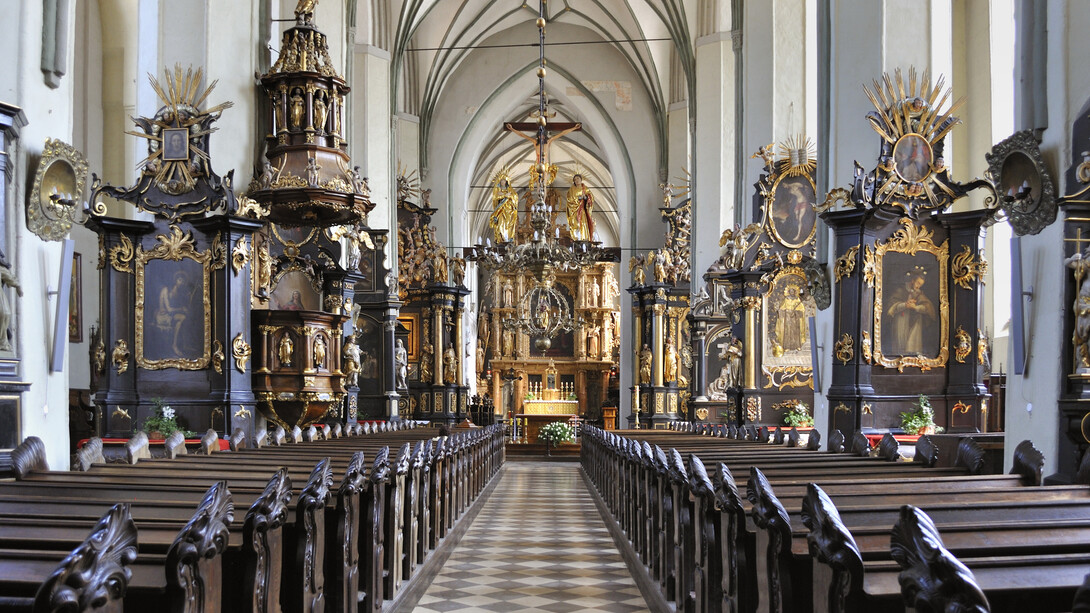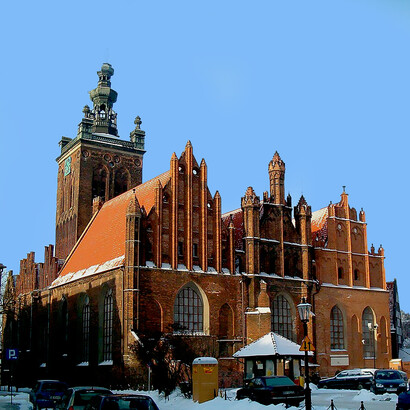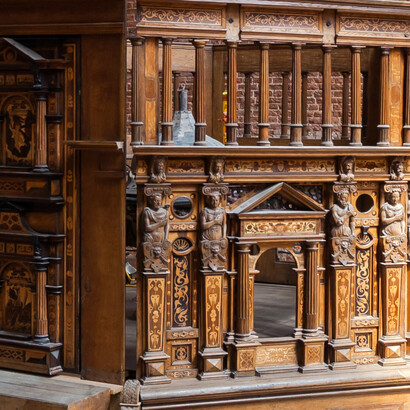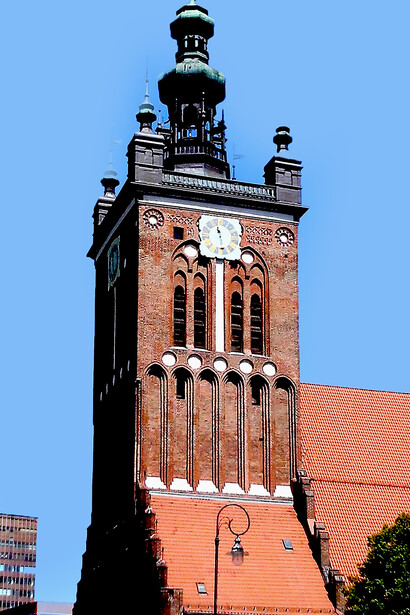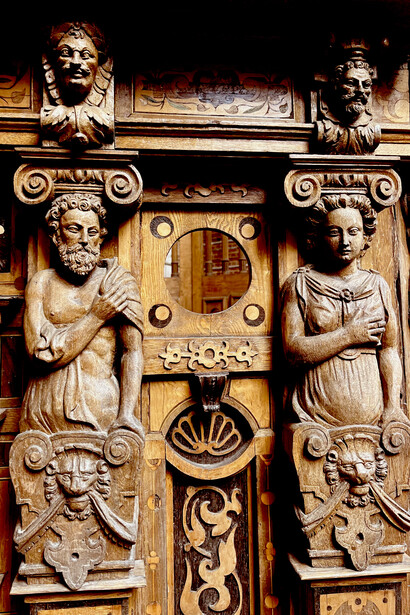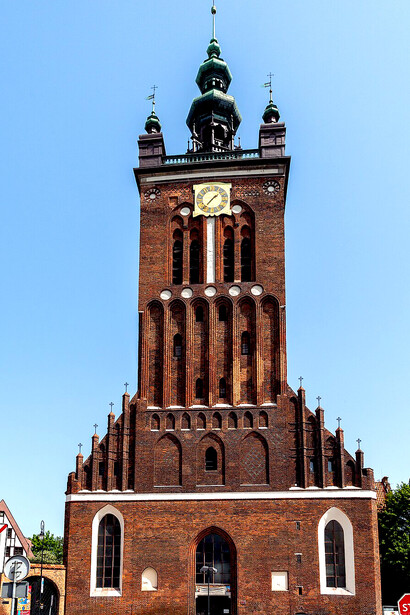When I entered the Gothic Church of St. Catherine (Kościół św. Katarzyny) in Gdańsk, my gaze was not drawn to the soaring vaults or the stained-glass windows, but to the wooden Renaissance baptistery standing in the northern aisle, where a shaft of light from the window happened to fall directly upon it: the wooden octagonal baptistery, crafted in 1585 by Mateusz Gletger.
Rays of sunlight filtered through the windows and fell directly upon it, illuminating its carved surfaces and throwing delicate shadows into the recesses of its ornament. In that moment, the baptistery seemed to gather the light and radiate it outward, its craftsmanship revealed in all its richness. This visual encounter became my main focus during the visit, and it continues to resonate as a profound example of how sacred art can embody both theological meaning and the highest levels of artisanal skill.
Mateusz Gletger and his masterwork
Later, I found that little is known about Mateusz Gletger himself. His name is preserved primarily through this singular masterpiece, but the survival of his work speaks volumes. In late sixteenth-century Gdańsk, a city flourishing as a port on the Baltic Sea and enriched by Hanseatic trade, artistic exchange was lively. Craftsmen and artists came into contact with Italian Renaissance ideals, German sculptural traditions, and local woodworking expertise. Against this backdrop, Gletger produced the octagonal baptistery that remains one of the most exquisite examples of Renaissance ecclesiastical furniture in Poland.
Dating to 1585, the baptistery reflects both the stylistic language of the Renaissance and the theological function it was designed to serve. Baptism, the Christian rite of initiation, is deeply tied to themes of rebirth, cleansing, and light. Gletger’s baptistery embodies these ideas not only through its form but also through the delicate, masterful craftsmanship that elevates wood into a medium of divine significance.
The octagonal form: symbol and harmony
The baptistery’s octagonal structure is its first striking feature. Octagons were favored in Christian architecture and furnishings associated with baptism because the number eight carries symbolic meaning. The seven days of creation culminate in the Sabbath, but the “eighth day” represents eternal life and resurrection. Baptism, therefore, was often linked to this symbolism as the “eighth day” of existence—a passage into spiritual renewal.
By giving the baptistery eight sides, Gletger was not simply adhering to a design convention; he was embedding the very geometry of salvation into the object. Standing before it, one feels the harmony of proportion, the way each panel contributes to a sense of balance, rhythm, and completeness. This geometry is a form of silent theology, expressed not in words but in the mathematical beauty of crafted wood.
Wood as a medium of transformation
While stone was often the material of monumental church furnishings, Gletger’s choice of wood for the baptistery demonstrates both the resources of Gdańsk and the extraordinary skill of its artisans. Wood in northern Europe was abundant, but raising it to the level of Renaissance artistry required both technical mastery and artistic vision. The baptistery showcases fine carving, delicate relief work, and a subtle interplay between smooth surfaces and sculptural detail.
Working in wood also allowed Gletger to achieve an intimacy and warmth that stone could not. The grain of the material, its responsiveness to the chisel, and its ability to hold intricate details all contribute to the unique tactile presence of the baptistery. The craftsmanship transforms the organic into the sacred: nature shaped by human hands becomes a vessel of divine grace.
Decorative language and Renaissance ideals
Although the baptistery’s precise decorative program deserves detailed study, even a visual encounter reveals the strong influence of Renaissance ornament. Classical motifs—columns, pilasters, and acanthus leaves—frame the panels, while figural and vegetal carvings enrich the surfaces. These details reflect Gdańsk’s openness to the Renaissance language of form, transmitted northward from Italy and adapted to local traditions.
The carvings are not mere embellishments; they are carriers of meaning. Scrollwork may evoke eternity, floral patterns the Garden of Paradise, and human figures the witnesses of faith. The entire structure becomes a microcosm of sacred history, condensed into a wooden octagon. Gletger’s craftsmanship achieves what the best Renaissance art always sought: the fusion of beauty and knowledge, decoration and doctrine.
The play of light
My encounter with the baptistery was defined by light. Entering the church, I saw how sunlight from the windows fell directly on the wooden surfaces. This illumination was not accidental. Renaissance artists and patrons were keenly aware of how light interacted with carved forms. The deep reliefs cast shadows that shift with the passing hours, animating the figures and patterns. The polished wood catches glimmers of brightness, enhancing the perception of depth and richness.
In Christian thought, light symbolizes divine presence. Baptism itself is often described as enlightenment, a passage from the darkness of sin into the light of grace. Thus, when sunlight illuminated the baptistery, it enacted in real time the spiritual symbolism of the sacrament. The craftsmanship, designed to receive and play with light, becomes a partner in this theological drama.
Context: Gdańsk in the late sixteenth century
Placing the baptistery within its historical context deepens our appreciation of its significance. In the late 1500s, Gdańsk was a prosperous city, marked by both Catholic tradition and the strong presence of Protestant communities after the Reformation. Artistic commissions in this period often reflected negotiation between these influences, as well as the city’s cosmopolitan connections to other Baltic and European centers.
The commissioning of such a finely wrought baptistery suggests both the importance of baptism as a unifying Christian ritual and the pride of the community in adorning its principal parish church. It also signals the skill level of local workshops. Gletger, by creating this masterpiece, inscribed himself into the artistic identity of Gdańsk, even if history has otherwise left him in obscurity.
Craftsmanship as theology
To focus on the craftsmanship of the baptistery is not to separate it from its theological function, but rather to see the two as inseparable. Every carved line, every proportion, every polished surface is a form of visual theology. The act of carving wood into harmonious form mirrors the act of baptism: shaping, cleansing, renewing. The artisan’s hand, disciplined and creative, becomes an analogue of divine grace working on the human soul.
The beauty of the baptistery thus serves a higher purpose. It is not beauty for its own sake but beauty in the service of salvation. To gaze upon it is to be reminded that Christianity has always communicated not only through scripture and preaching but also through the material eloquence of art.
For me, standing before Mateusz Gletger’s baptistery was an experience of discovery. The church of St. Catherine is filled with art, architecture, and history, but it was the baptistery—lit by sunlight—that became my main focus. It commanded attention not by size but by its concentrated beauty, its harmonious proportions, and the sense of sacred purpose embedded in its form.
I found myself drawn into its details: the way the carved patterns interwove, the rhythm of the octagonal panels, the subtle gleam of polished wood. In that moment, the baptistery was not merely a historical artifact but a living presence, inviting contemplation. Its beauty was inseparable from its theological message: that baptism is both a communal act and a personal transformation, both a ritual of water and an illumination by light.
